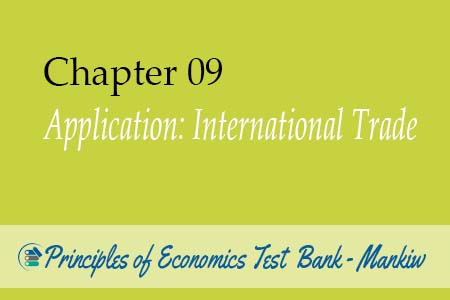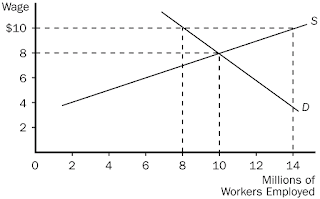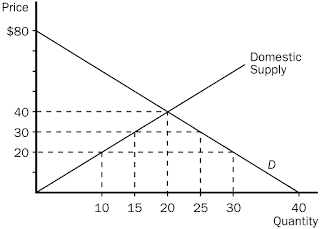
1. Nations would gain
from trade if a(n) __________ exists.
a. absolute advantage
b. specialization
c. comparative advantage
d. infant industry
2. If Canada has a
comparative advantage over Denmark in the production of wood, this implies that
a. it requires fewer resources in Canada than in Denmark to
produce wood.
b. the opportunity cost of producing wood in Canada is lower
than in Denmark.
c. Denmark does not benefit by trading with Canada.
d. Canada should buy wood from Denmark.
3. If two countries
specialize
a. the other countries trading with them cannot specialize.
b. everyone in both countries benefits.
c. the total of goods produced increases.
d. all goods will be produced in both countries.
4. As a result of
free trade in a commodity, the
a. price of the commodity must be the same in all countries.
b. total quantity imported will exceed the total quantity
exported.
c. price of the commodity will be higher in the producing
country.
d. price of the commodity will be lower in the producing
country.
5. If at the world
equilibrium price the U.S. quantity demanded is greater than the U.S. quantity
supplied, then the
a. United States will import the good.
b. United States will export the good.
c. world price will fall.
d. world price will rise.
6. Consider this
diagram of the market for pocket calculators in Venezuela. In the absence of
trade, the price and quantity of calculators sold are
a. $3.00 and 10 calculators.
b. $3.00 and 60 calculators.
c. $8.00 and 60 calculators.
d. $8.00 and 80 calculators.

7. Consider this
diagram of the market for pocket calculators in Venezuela. With free trade,
Venezuela produces __________, consumes __________, and imports __________.
a. 10 calculators; 80 calculators; 70 calculators.
b. 10 calculators; 110 calculators; 100 calculators.
c. 40 calculators; 40 calculators; 20 calculators.
d. 80 calculators; 110 calculators; 30 calculators.
8. Consider this
diagram of the market for pocket calculators in Venezuela. With free trade,
consumer surplus
a. increases by 300.
b. increases by 425.
c. decreases by 125.
d. None of the above are correct.
9. Consider this
diagram of the market for pocket calculators in Venezuela. A tariff would
completely eliminate imports of calculators if it equaled
a. $2.00.
b. $3.00.
c. $4.00.
d. $5.00.
10. Consider this
diagram of the market for pocket calculators in Venezuela. With a per-unit
tariff of $3.00, the Venezuelan government collects tariff revenues of
a. $80.00.
b. $100.00.
c. $120.00.
d. $140.00.
11. If the
opportunity cost of a television set equals 20 cameras in China, but 10 cameras
in Japan, then we know
a. China has a comparative advantage in producing cameras.
b. Japan has a comparative advantage in producing TV sets.
c. market exchange of 1 TV set for 15 cameras would produce
not only mutually beneficial trade, but would also split the gains from trade
equally between the two countries.
d. All of the above are correct.
12. When customers
are free to buy at the lowest prices, they will
a. purchase goods from the country that has a comparative
advantage in producing it.
b. purchase only goods produced in their own country.
c. purchase only goods produced in their own local area.
d. prefer to purchase only well-made, foreign-produced
goods.
13. With
international trade
a. producers and consumers in both countries must gain;
otherwise, there would be no trade.
b. producers in both countries must gain.
c. consumers in both countries must gain.
d. consumer surplus in the country that imports the good
rises.
14. The United States
is the world’s leading grain producing nation. Exporting U.S. grain causes the
a. domestic consumption of grain to rise because of the
added foreign demand.
b. price of grain in the domestic market to fall because
foreigners are now taking some of the domestic demand.
c. price of grain to domestic consumers to rise because of
the added foreign demand.
d. U.S. standard of living to improve but reduces the
standard of living of foreigners.
15. If the United
States imports shoes in a free-trade situation, we can infer that
a. the domestic production of shoes in a no-trade situation
is lower than if there is free trade.
b. domestic consumption of shoes is higher in a no-trade
situation than if there is free trade.
c. the domestic price of shoes in a no-trade situation is
higher than the free-trade world price.
d. the domestic price of shoes in a no-trade situation is
lower than the free-trade world price.
16. Domestic
producers gain from the opportunity to export goods to foreign countries
because
a. the free-trade price of the good is higher than the
domestic price in the absence of trade.
b. producers are able to reach a wider market.
c. although the free-trade price is lower than in the
absence of trade, producers are able to sell a greater quantity.
d. production rises, although there is no change in the
price of the good compared to the no-trade situation.
17. Consider this
diagram of the market for tea in China. If the world price is $20, consumer
surplus is
a. $60.
b. $600.
c. $900.
d. $1800.

18. Consider this
diagram of the market for tea in China. If the government imposes a quota of 10
units of tea per day, the consumer surplus will
a. $50.
b. $625.
c. $900.
d. $1250.
19. Consider this
diagram of the market for tea in China. If the government imposes a quota of 10
units of tea per day, the import license holders receive
a. $50.
b. $100.
c. $625.
d. $225.
20. Consider this
diagram of the market for tea in China. If the government imposes a quota of 10
units of tea per day, the deadweight loss will be
a. $50.
b. $100.
c. $225.
d. $275.
21. One big
difference between tariffs and quotas is that tariffs
a. raise the price of a good while quotas lower it.
b. generate tax revenues while quotas do not.
c. stimulate international trade while quotas inhibit it.
d. hurt domestic producers while quotas help them.
22. Suppose the
United States decides to impose a $1,000 tax on every Japanese minivan sold in
the United States. This is an example of
a. a tariff.
b. a subsidy.
c. comparative disadvantage.
d. a quota.
23. The U.S. military
aircraft industry sought protection from foreign competition by using the
__________ argument to persuade Congress to impose trade restrictions.
a. infant industries
b. national security
c. unfair competition
d. protection-as-bargaining-chip
24. A less-developed
country would probably use __________ to argue for trade restrictions.
a. national security
b. infant industry
c. increased efficiency
d. unfair competition
25. Many U.S.
producers complain about limited access to the Japanese market. They say that
they cannot export to Japan because Japanese import restrictions are so severe.
Who gains? Who loses?
a. Everyone loses.
b. Japanese producers gain, U.S. producers and Japanese
consumers lose.
c. Japanese producers and consumers gain, U.S. producers and
consumers lose.
d. Japanese consumers and U.S. consumers gain, Japanese
producers lose.
26. Textile workers
in the U.S. complain that they cannot compete with low-cost, foreign textile
producers. While some U.S. textile workers may lose their jobs, an advantage is
a. the United States gets cheaper textiles.
b. U.S. imports will become more expensive so U.S. domestic
producers gain.
c. workers in other countries will buy more U.S. clothing.
d. the United States can retaliate with punishing trade
policies.
No comments